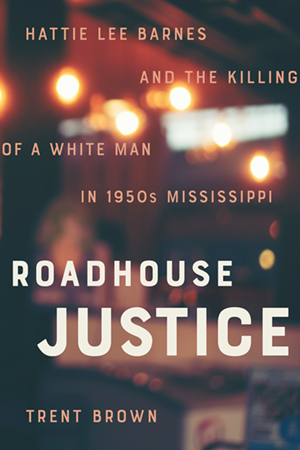
224 pages / 6.00 x 9.00 inches / 9 halftones, 1 map
History / United States - Southern History | True Crime / Murder
In 1951, a young Black woman, working as an overnight caretaker at a county-line beer joint in southwestern Mississippi, shot and killed a white intruder who was likely intending to assault her. Hattie Lee Barnes’s killing of Lamar Craft threw the courts into a whirlwind of conflicting stories and murder attempts, illuminating the capriciousness of Mississippi justice, in which race, personal connections, and community expectations mattered a great deal.
In Roadhouse Justice, Trent Brown examines the long-forgotten circumstances surrounding this case, revealing not only the details of Craft’s death and the lengthy court proceedings that followed, but also the precarious nature of Black lives under the 1950s southern justice system. Told here in full for the first time, the story of Barnes’s tribulations and ultimate victory demonstrates her intense determination and refusal to buckle under the enormous pressures she faced.
Trent Brown is professor of American studies at Missouri University of Science and Technology. Brown is the author of multiple books, including Murder in McComb: The Tina Andrews Case.
“Brown’s meticulous research tracks with precision a complex and bewildering series of events across three counties in southwest Mississippi on the eve of the civil rights movement. Readers will find in Roadhouse Justice a true crime narrative that seems at once familiar and mystifying; an authentic and fascinating reveal of the strange interplay of race, class, and sex in the segregated South.”—Stephanie R. Rolph, author of Resisting Equality: The Citizens’ Council, 1954–1989
“This diligently researched, absorbing, and clearly written study tells the story of Hattie Lee Barnes on its own terms, clarifying its linkages to the modern civil rights movement. It is the byproduct of a painstaking research process that takes us to the scene of the crime she allegedly committed in 1951, killing a white man attempting to rape her, while also taking its readers on a journey back in time to the local community where it happened. Brown draws portraits of all the key players, while clarifying insurgent practices in law and journalism that helped to establish truth in a time when justice was so frequently denied to Black people, whose lives and experiences were less likely to be documented. This fine study’s methodology illustrates historiography at its best.”—Riché Richardson, author of Emancipation’s Daughters: Reimagining Black Femininity and the National Body
Found an Error? Tell us about it.